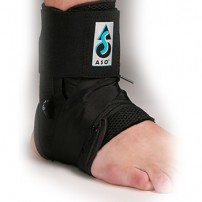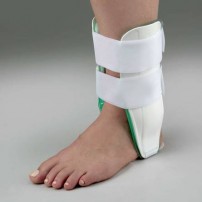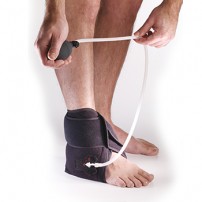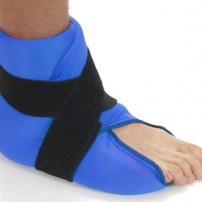The Injured Ankle
Things you should know about ankle injuries
Mechanism of injury or “what the heck did I do?”
Most ankle injuries are the result of “rolling over” the outside of the ankle. The ligaments can be stretched or torn and the treatment depends on the extent of the damage.
Immediate treatment

Should always include Rest – Ice – Compression – Elevation or RICE until you have seen a health care professional. Then you may be placed in a cast, splint or ankle brace with or without crutches.
Treatment
Today the emphasis is on early protective movement and at the same time, preventing motion in the direction of the injury. The Air Cast ankle brace is often used in the initial phase of the injury due to it’s ability to provide two of the essential components of immediate care *compression and protection. You can continue to move the foot up and down but not in and out.
Rehabilitation
The key works are “stretching and strengthening”. Stretching the calf muscles and strengthening the muscles that pull the foot up and out are important to rehabilitation program and reducing the risk of another injury.
Strengthening the calf and ankle
When you strengthen and stretch, you really complete the rehab cycle and reduce the probability of another injury. These strengthening exercises are simple and effective and will help keep you in the game.
Method:
Theratubing/Theraband TM are ideal for providing resistance. Hook one end to a stationary object at floor level. Make a loop in the other end and hook around your forefoot. Scoot back until there is slight tension in the cord and your foot is flexed foreword. With your knee straight, flex your forefoot and toes toward you at a fairly rapid pace. Continue to do this until you feel like you “just can’t do it one more time”. Rest for 30 seconds and repeat. Rest again and repeat a third set.


Using the same method and position as above, flex the foot up and to the outside like you are pulling your little
toe toward your hip. Repeat as described above.
Protecting the ankle
Most people feel better when they have additional protection on their injured ankle. This is where an ankle support is useful. Whether it is tape or a manufactured brace, the principle is the same. You need to reduce the chance of “rolling over” on the ankle. Taping the ankle is effective but is short on duration and you need a trainer to properly apply it. Also, tape tends to lose it’s strength when you perspire and therefore you have a reduction in the amount of protection you are getting. The solution is a commercially available support that not only fits your needs but closely duplicates the taping configuration a trainer uses when taping an ankle. It must be easy to put on, comfortable and most importantly, meets your needs. At SEE THE TRAINER we recommend the following ankle supports:
Kallassy * Sweedo * Cooper II * Active Ankle * Air Cast
REMEMBER! An ankle support without proper rehabilitation will not give you the protection you need. The support works best when combined with exercise and stretching.
Stretching the calf muscle
One major cause of ankle re-injury is tight calf muscles. Sit down with your knees straight and see how far you can pull back your toes and foot on the injured side versed the uninjured one. The odds are that there will be a loss of motion due to a tight calf muscle. When you shorten the distance the foot can be brought back, you increase your chance of “rolling over” on that ankle.
How to stretch

Method one: put your forefoot on a 2″ to 3″ thick board or block. With your back straight and your knee straight, lean into the wall – hold for 10 seconds and relax. Repeat this for two to three minutes. Do the same thing with the knee bent slightly. Keep working on this on a daily basis until you can flex the injured ankle as far as the other one.
ProstretchTM: This device is useful in both stretching and strengthening and optimally positions the foot for maximum stretch of the calf muscle through a variety of degrees of motion. Also can be used for effective strengthening of both ankles.



